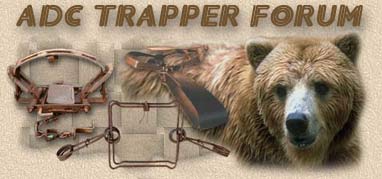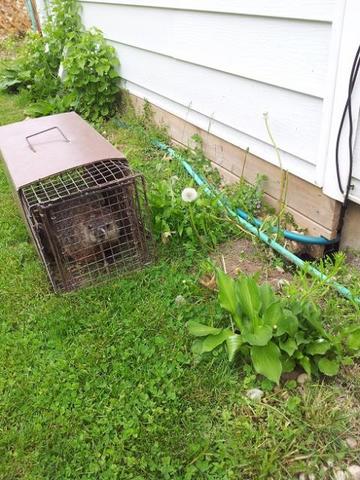I try to be analytical, merely going over each of the known, anticipated scenarios one by one, which will in the end usually dictate the correct approach or at least make you aware of the trade offs, plusses and minuses. When we set conibears in a positive set in a den hole we don't think twice, which is the basic premise for a double door cage trap, just a "wire box conibear" with a live chuck. The cage is quick and easy and comes with peace of mind in suburbia. Never want the "cure" to be worse than the disease.
I was asked the definition of a blind set. It is merely an unbaited set placed anywhere in a trail or travel way or a den, which has been named a positive set. When I get a call on skunks or chucks I usually ask, "do you have a fence or an out building." Most often the answer is yes and the land owner will frequently volunteer that there is a hole under one or both, great blind sets. A flush mount internal door double door cage trap or cage trap with an external door and a nose cone will cover either opening to take the chuck, skunk, possum armadillo, whatever, both coming and going, just like a conibear, but minus the danger. As a plus, in using both cages and conibears I have found that cages are no less effective a tool than a conibear for these animals and more, actually more effective for several reasons concerning the nature of the function of each device, another topic.
If den holes are not readily available, the hole is on the neighbors property and for some reason you can not access it, chucks love to travel along the edge of buildings, fences, walls etc. any structure, so a pinch point between a wall and a bush is all it takes. Set and place the trap, done. You can see where chucks part the grass especially when it is tall. Again a double door cage in the travel way will take him. I like to put some grass in the bottom of the cage and sprinkle some on the cage to blend it, but chucks don't seem to do a lot of avoiding. They are used to humans and all the plastic, metal and junk we leave all over the place.
Had to laugh about a story of a coyote caught in a double door cage. The 'yote was coming in to a junk yard, nothing but steel. They had a pinch point and covered the trap with mufflers, tail pipes etc. Nabbed him first night. Guess its all relative.
Once you have made a blind set, there is nothing to preclude you from adding some bait or lure if you feel the need, but then you are back to attracting the non targets, which slows the process in more trips and sometimes the client will balk at additional charges for a mess of unwanted unintentional catches.




